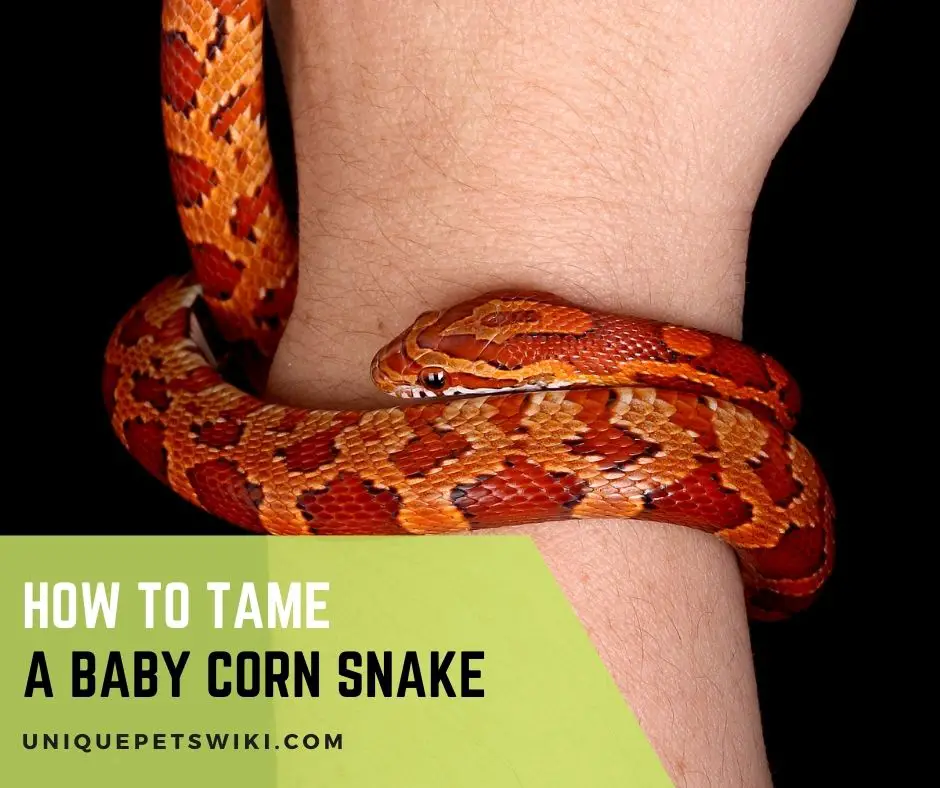Corn snakes are reptiles you can keep as a pet as a beginner hobbyist due to their docile demeanor. However, corn snakes can be nervous, aggressive, and defensive, especially baby corn snakes. As a responsible corn snake owner, you may wonder how you can tame your baby corn snake.
Contents
Is Baby Corn Snake Easy to Tame?
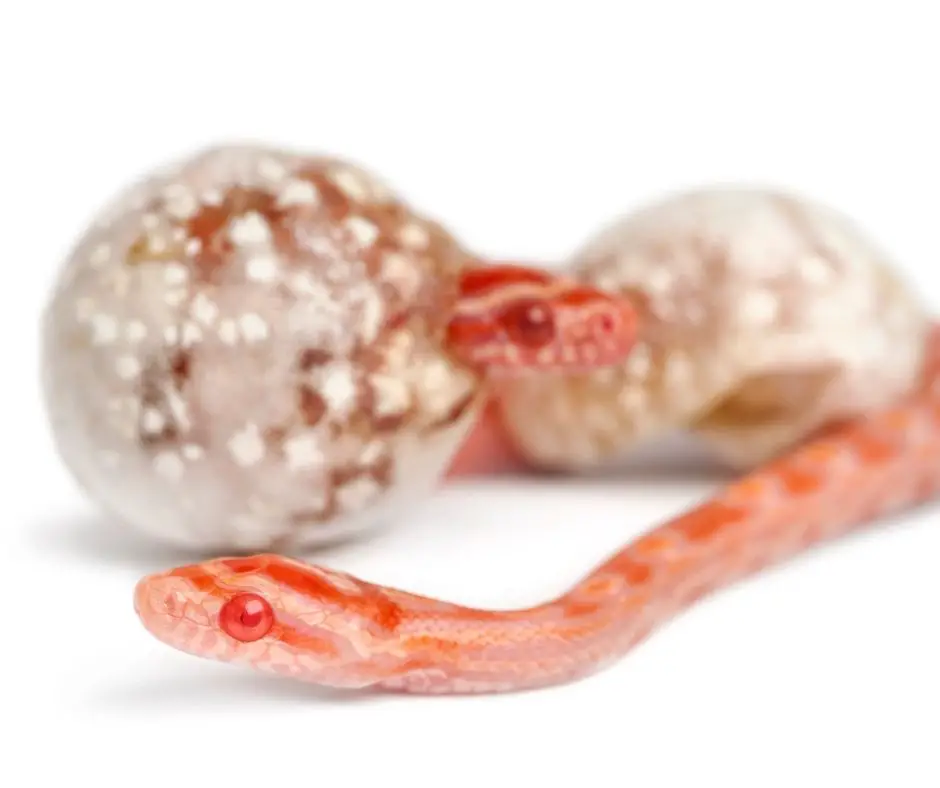
It is easier to tame a baby corn snake than even an adult one. You will notice that a baby corn snake can hide or defend itself during taming. The good thing is that they cannot really harm you and will get used to you in no time.
This article will provide insight into everything you need to know about taming baby corn snakes and all the helpful tips you can follow when handling your snake to keep it comfortable.
How to Tame a Baby Corn Snake
As stated before, taming a baby corn snake is quite easy. You must give your baby corn snake some weeks to settle into its new home while you build trust. You can then start a brief handling session until you are sure the snake is not struggling.
Here are steps that you can follow to tame a baby corn snake.
Step 1: Build Trust Before You Attempt to Handle
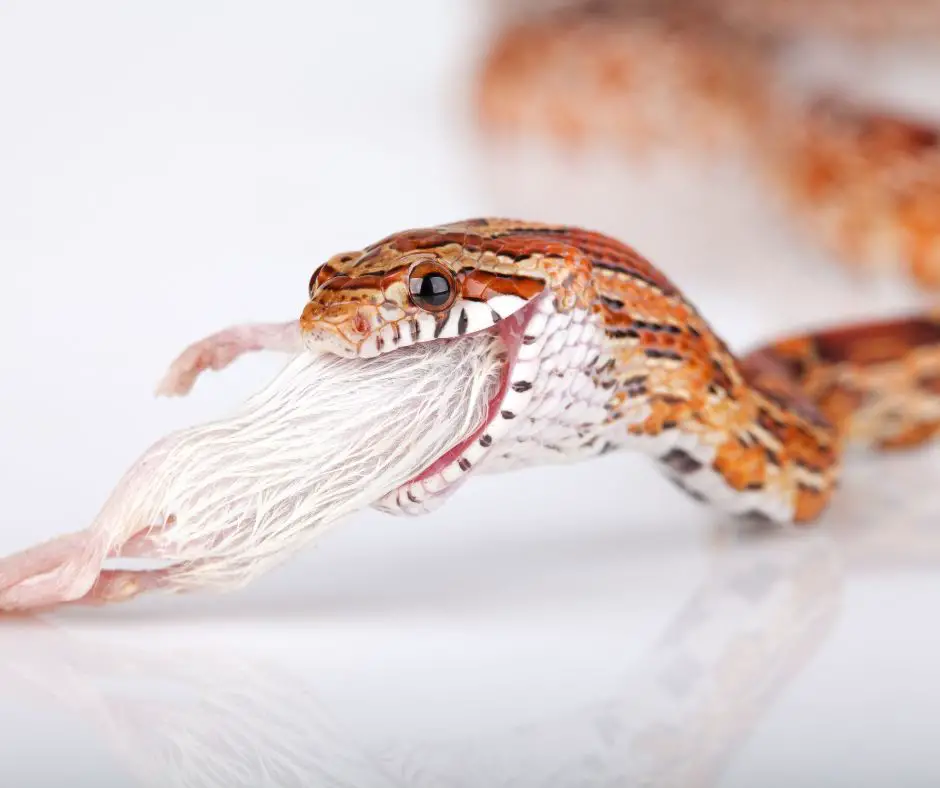
The first step to taming a baby corn snake is to build trust with it before you even carry it. You can do this by giving your snake time to adjust to you and settle in and get comfortable with its new surroundings.
The time to adjust to new surroundings usually varies from one corn snake to another. However, this usually takes around 2 weeks. Another thing is that you should not handle a baby corn snake until you are sure it is regularly eating.
Once you notice that your corn snakes have three to four successful meals, it indicates that it is getting used to its surroundings and you can start approaching it. You can make your corn snake get used to you by moving the accessories in their cage without touching the snake.
You can then go further by placing your hand flat in the enclosure close to your snake to investigate and get used to it. You can also talk to your snake when it is out of its hide to help ensure they get used to your smell and voice.
Step 2: Begin With Brief Sessions of Handling
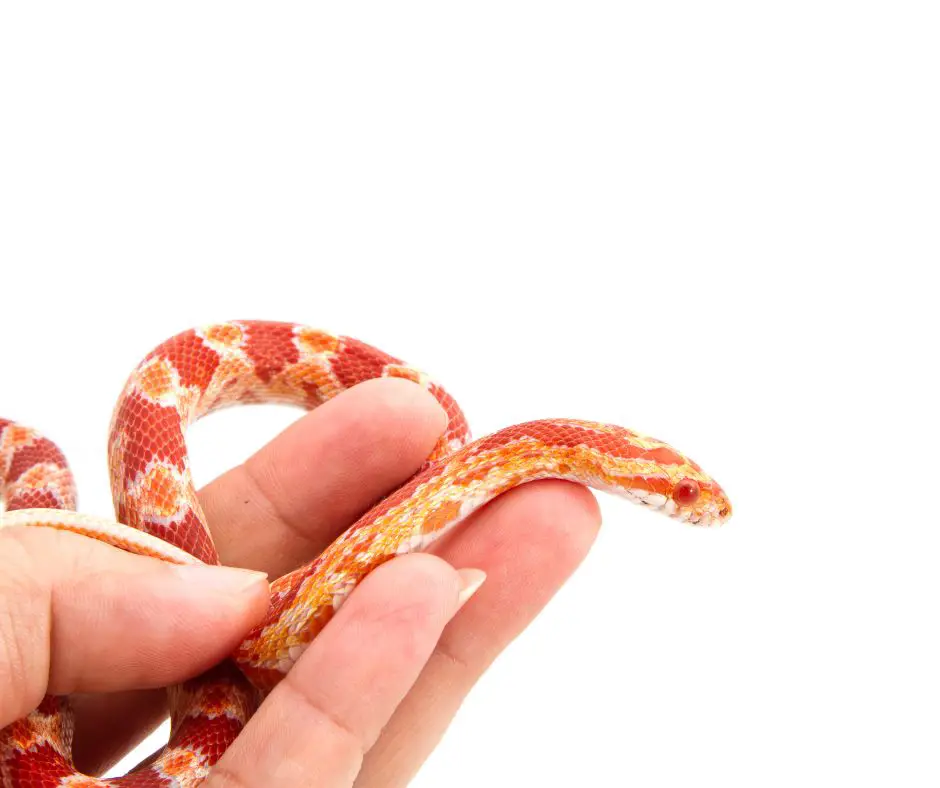
Once you are sure your baby corn snake is ready for handling, you can then start handling your snake briefly. This handling session should be no longer than 5 minutes, and you should ensure you don’t return the snake into its enclosure until it is calm.
This will help to make your snake react positively to handling. Here are steps you can follow when handling a baby corn snake for the first time.
- Ensure your baby corn snake is awake before you try to pick it.
- Always try to move your hand to your baby corn snake from the side rather than from above so it does not think you are a predator.
- Lift your baby corn snake gently and confidently from its enclosure to start the session.
- Cup your hands together to allow your snake to move around your cupped hands and explore its surroundings.
- Always have your second hand in place to catch your snake once it moves away from your first hand.
Note: handling sessions for a baby corn snake should be in short intervals (no longer than 5 minutes), but you can increase the length gradually.
Step 3: Continue Regular Sessions
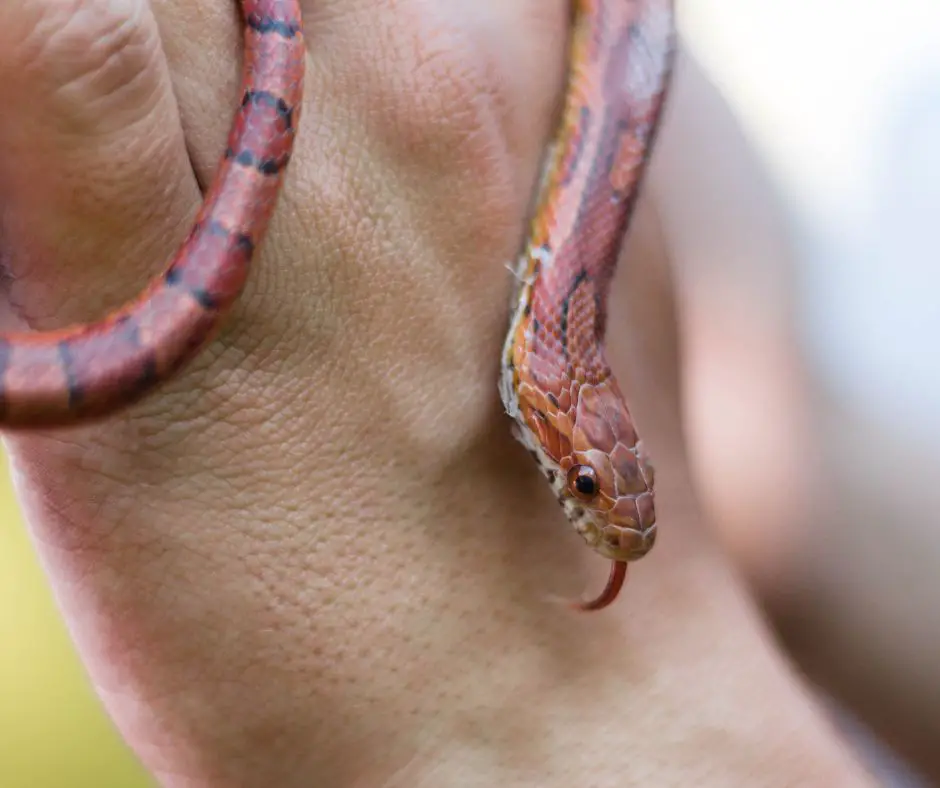
The next thing is to ensure you handle your baby corn snakes regularly to help ensure your snake stays tame. You will need to handle your corn snake at least once or twice per week, but you should not handle it more than once a day.
Although snakes do not need social interaction to stay healthy, handling them regularly helps make them realize you are not a threat. It is also a good opportunity for them to exercise.
Understand Baby Corn Snake Body Language for Better Taming
Corn snakes use a wide range of body language to communicate whether they are happy or stressed. Understanding these body languages will help you to better tame your snake. Some common corn snake body language and its meaning are stated below.
- Tongue flicking in and out: Corn snakes flick their tongue in and out to smell the air. This helps them to detect if prey or a human is nearby. It is also a great way to determine that your snake is awake.
- No movement or tongue flicking: This behavior indicates your snake is probably sleeping. You should approach your snake with caution when sleeping to avoid startling them.
- Head retracted, neck coiled into ‘S’ shape: A corn snake behaves this way when they feel threatened and prepares to defend itself when necessary. You can also notice this behavior when they are about to strike their prey.
- Hissing: This shows your snake is stressed or threatened and does not want you to handle them. You can leave your snake alone when they are hissing.
- Tail shaking/rattling: This indicates that your snake is threatened and trying to scare its perceived predator.
- Musking/defecting during handling: this shows that your corn snakes see you as a predator, and it is trying to use the unpleasant musk or poo to scare you away.
- Aggressive/bite: this shows that your snake is nervous or perceives you as a threat, and they can then bite to defend themselves.
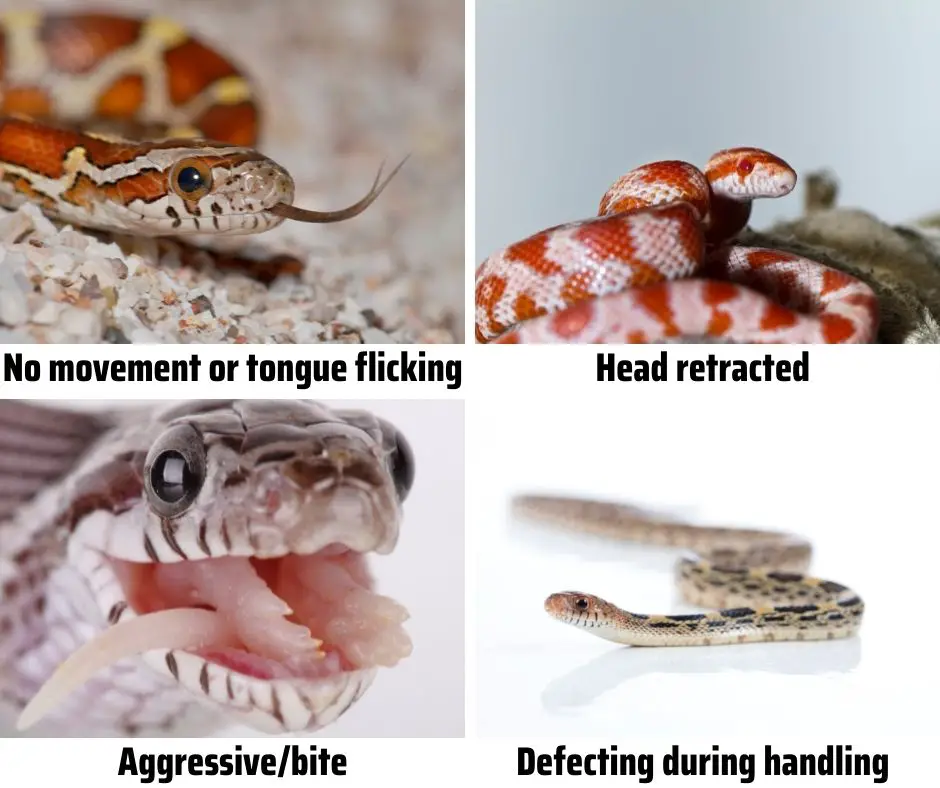
When NOT to Hold Your Baby Snake
Handling can cause discomfort to your baby snake if done at the wrong time or not done well. Some of the time you should avoid handling your baby snake are stated below.
It is best to avoid handling your baby corn snakes when it is hungry. This is because your snake may be more aggressive as it is ready to hunt for food.
You should avoid handling your baby corn snakes if they just ate in the last 48 hours. Handling your corn snakes after a meal can be highly stressful to the snake and can cause regurgitation or even kill the snake.
Avoid handling your snake when it is shedding. Snakes are usually extra defensive during the shedding period and can attack you if not careful. You can determine that your snake is shedding if it has bluish or cloudy eyes.
Rather, please wait until your snake is done shedding before you try to handle it.
You should also avoid handling your snake when ill or injured as it will become more stressed, causing more health problems.
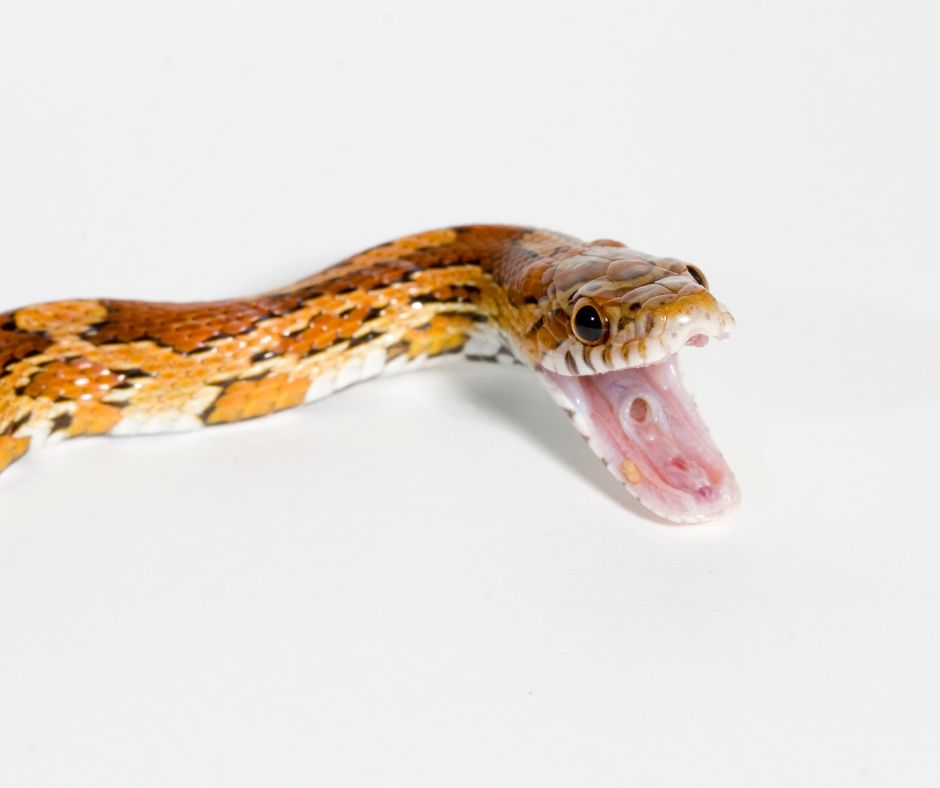
Note: Always be on the lookout for your snake’s body language before you handle them. Once you notice any discomfort in your snake when you try to handle them, it is best to let it be until it is ready for handling.
General Tips for Handling Your Baby Corn Snake
Here are some helpful tips you can follow to help you correctly handle your baby corn snake.
- Be confident whenever handling your snake.
- Wash your hands before and after handling your corn snakes.
- Avoid restraining your snake’s head during handling.
- Always point your snake’s head away from you when handling.
- Always support your snake fully to help ensure it feels safe during the handling session.
- Use one hand to hold 1/3 of your snake’s body while the other hand can be used to support the other 2/3 of the body along its hull.
- Avoid handling your snakes two days after feeding them.
How Long Does It Take to Tame a Baby Corn Snake?
There is no exact timeline for how long it will take for a baby corn snake to be tamed. How long your corn snake will be tamed is based on the corn species and the steps you take. However, it will take around 2 weeks to tame a baby corn snake.
You should ensure that your baby corn snake is regularly eating before starting the handling process. Furthermore, handling your baby corn snakes regularly will make it easier to tame them.
How Often Should You Handle Your Baby Corn Snake?
It is recommended that you handle your baby corn snakes regularly to help ensure they get used to you. You can handle your snake at least twice a week. However, you should avoid handling your snake more than once per day to ensure it does not get stressed out.
The handling process should not be longer than 5 minutes first, and you should not return the snake until it is calm. You can increase the handling time to about 10 minutes longer as your snake becomes more familiar with handling.
How To Know If You Have Successfully Tamed a Baby Corn Snake?
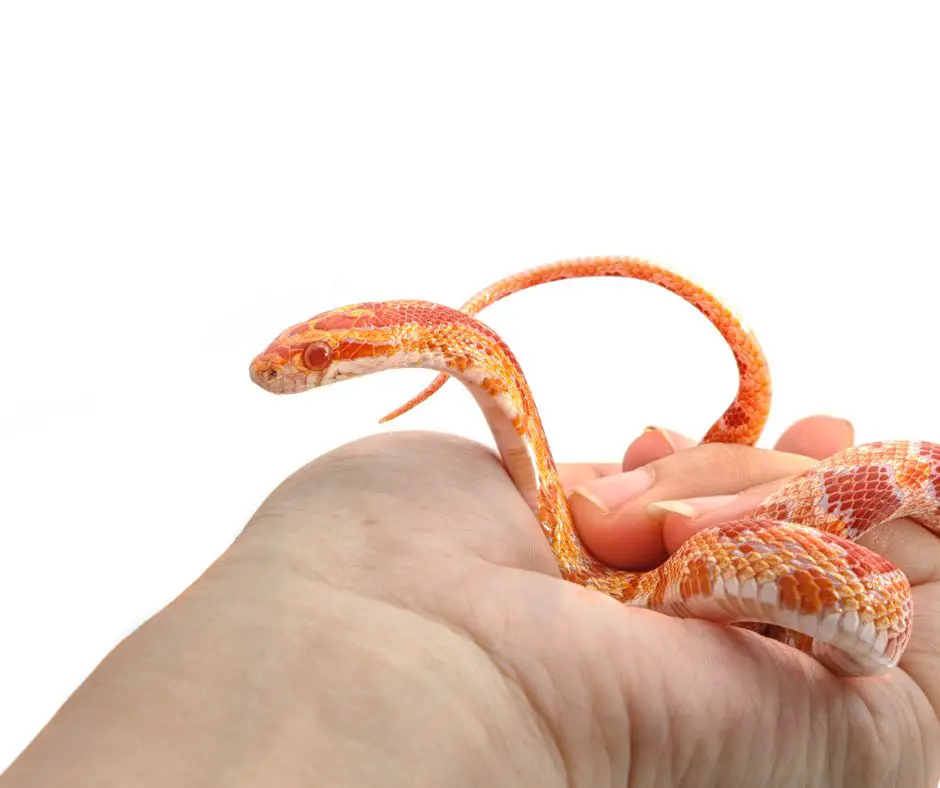
Here are some signs that indicate that you have tamed your baby corn snake successfully:
- Your snake makes calm and unhurried movements when you are around its cage.
- Your corn snake calmly explores you when you hold it.
- Your snake takes its food from you or while you are around its cage.
- The snake moves to the front of the enclosure when you are present around its cage.
- It rests on you when you place your hand in its enclosure or during handling.
- Your corn snake behaves differently whenever it is with you.
- It is exploring instead of hiding whenever you are around.
(2 Pack) Zoo Med Deluxe Collapsible Snake Hook
- Adjustable from 7-1/4 to 26" (18cm to 66cm)"
- Not for use with venomous reptiles
- Can also be used to inspect cage furnishings
- Adjustable
- Pack of 2
Last update on 2022-12-30 / Affiliate links / Images from Amazon Product Advertising API
FAQs
How do you get a corn snake to trust you?
You can get your corn snake to trust you by spending more time with your snake, and this will help to make it familiar with your presence. Handling your corn snake regularly will also help build trust as your snake will get more relaxed whenever you are around and will not see you as a threat.
Does a baby corn snake bite hurt?
A baby corn snake bite does not hurt, and you probably will not feel anything after the bite. Even adult corn snake bites feel like a pinch and will only draw little or no blood.
Why does my baby corn snake always hide?
Generally, corn snakes are nocturnal creatures and are usually active at night. This is why they tend to hide more during the day. Some of the other reasons for a baby corn snake to hide are:
– It is about to shed.
– Your baby corn snake is not used to handling.
– It has not fully digested its last meal.
– Your baby corn snake is settling into its new home.
– Your corn snake is too shy.
– Your snake is too cold.
How do you pick up a scared corn snake?
You may need a snake hook or wire coat hanger (for baby snakes) to pick up a scared corn snake. Some of the steps that you can follow are:
– Gently slide the hook under the corn snake right at the middle of its body.
– Lift the snake and ensure its head is pointing away from you.
– Slide a hand under your snake’s mid-body area where the hook is.
– Support your snake using one hand, and then remove the hook.
– Place your other hand under the snake for more support.
Final Sentences
Corn snakes are considered by many to be relatively docile snakes. However, they are usually aggressive and nervous as a baby, and it is important to tame them so they can see that you are not a threat to them.
The good thing is that taming baby corn snakes is quite easy and will be tamed in no time using the approved methods.
Furthermore, you will also need to continue to handle your snakes regularly to help keep them docile and used to you.
